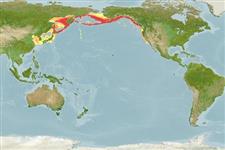Classification / Names
Common names from other countries
Main reference
Size / Weight / Age
Max length : 119 cm TL male/unsexed; (Ref. 40637); max. published weight: 22.7 kg (Ref. 27436); max. reported age: 25 years (Ref. 55701)
Length at first maturity
Lm 67.0, range 40 - 85 cm
Environment
Marine; brackish; demersal; oceanodromous (Ref. 51243); depth range 10 - 1280 m (Ref. 50550), usually 100 - 400 m (Ref. 54440)
Climate / Range
Boreal, preferred 4°C (Ref. 107945); 79°N - 43°N, 156°W - 45°E (Ref. 54442)
Distribution
Gadus ogac is reported from the eastern Beaufort Sea and eastward across the Canadian Arctic including the Boothia Peninsula in Hudson and James Bays and Hudson Strait, the entire coast of Labrador and into the Gulf of St. Lawrence; southern limit is Cape Breton, Nova Scotia.
Countries | FAO areas | Ecosystems | Occurrences | Introductions
Short description
Dorsal
spines
(total): 0;
Dorsal
soft rays
(total): 37-57;
Anal
spines: 0;
Anal
soft rays: 31 - 42;
Vertebrae: 49 - 55. Distinguished by the presence of 3 dorsal and 2 anal fins, a long chin barbel (about 3/4 as long as the eye diameter in young, longer than eye diameter in adults), and a space between the second and third dorsal fins that is shorter than the eye diameter (Ref. 27547). Lateral line with a prominent arch under the 1st and 2nd dorsal fins, is straight toward the tail, ending under the 3rd dorsal (Ref. 27547). Brown or gray dorsally, becoming paler ventrally; dark spots or vermiculating patterns on the sides (Ref.1371). Yellow color phases are known (Ref. 27547). Fins dusky; dorsal, anal and caudal fins with white edges that are wider on anal and caudal than on dorsal (Ref. 27547).
IUCN Red List Status (Ref. 115185)
Threat to humans
Harmless
Human uses
Fisheries: highly commercial; gamefish: yes
Tools
Special reports
Download XML
Internet sources
Estimates of some properties based on models
Phylogenetic diversity index
PD50 = 0.6250 many relatives (e.g. carps) 0.5 - 2.0 few relatives (e.g. lungfishes)
Trophic Level
4.2 ±0.1 se; Based on diet studies.
Resilience
Medium, minimum population doubling time 1.4 - 4.4 years (Preliminary K or Fecundity.)
Vulnerability
Moderate to high vulnerability (50 of 100)
Price category
